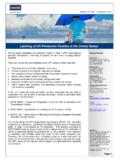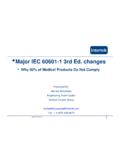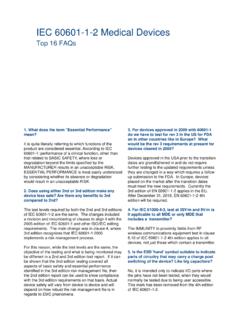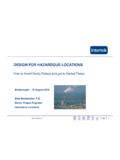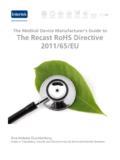Transcription of Testing and Certification for PPE Gloves & the EU …
1 Testing and Certification for PPE Gloves & the EU Regulations intertek Centre Court, Meridian Business Park, Leicester LE19 1WD UK. The Warehouse, Brewery Lane, Leigh, Lancashire WN7 2RJ UK. +44(0)116 263 0330 or +44(0)1942 265 700 Testing & Certification for PPE. Gloves & the EU Regulations Contents Contents .. 1. The Procedure for Testing and CE Marking Gloves .. 1. Glove Testing by Type and Corresponding Standards .. 1. EN 420 Protective Gloves General 2. EN 388 Protective Gloves against Mechanical Use .. 3. Levels of Protection for EN 388 .. 4. EN 374 Protective Gloves against Chemicals and 4. EN 407 Protective Gloves against Thermal Risks (Heat and/or Flame).. 5. EN 12477 Welders Gloves .. 6. Additional Types of PPE Gloves and 6. PPE & the European Community Directive .. 7. Technical Files .. 8. Other Regulations .. 9. Certification .. 9. Who are intertek ?.. 9. The Procedure for Testing and CE Marking Gloves PPE Glove products are divided into types dependent upon the intended end use.
2 Each of these types is equivalent to the different levels of protection they provide to the wearer. There are many types of PPE Gloves . Those detailed in this article are protective Gloves against mechanical use, protective Gloves against chemicals and micro-organisms, protective Gloves against thermal risks (heat and/or flame), welders' Gloves , protection against cold Gloves , handheld chainsaw Gloves , fire fighter Gloves , ionizing radiation Gloves , motorcycle Gloves and sports Gloves . The Testing required for PPE Gloves is also dictated by these different types of Gloves and their corresponding standards. Glove Testing by Type and Corresponding Standards Protective Gloves General Requirements - EN 420. Protective Gloves against Mechanical Risk EN 388. Protective Gloves for Chemical and Micro-Organisms EN 374. Protective Gloves for Thermal Risks - Heat and/or Flame EN 407.
3 Protective Gloves for Welders EN 12477. Protective Gloves for Cold EN 511. 1. Testing & Certification for PPE. Gloves & the EU Regulations Protective Gloves for Handheld Chainsaws EN 381. Protective Gloves for Fire Fighters EN 659. Protective Gloves for Ionizing Radiation EN 421. Protective Gloves for Professional Motorcycle riders BS EN 13594. Protective Gloves for Sport Various standards dependent upon the sport EN 420 Protective Gloves General Requirements EN 420 Protective Gloves General Requirements specifies all the basic requirements for PPE Gloves and the following Testing including: 1. General requirements for glove design - The glove must give the end user the highest levels of protection and be designed to minimise the time required for putting on and removing. 2. Resistance to water penetration (if required) - Provides an indication of how water resistant the materials used to manufacture the Gloves are.
4 3. Innocuousness Innocuousness is the restriction of banned substances which cannot be used in components making up the Gloves , for example: pH value of leather to a minimum requirement and the presence of chromium VI. 4. Cleaning - Cleaning instructions including how to take care of the Gloves during their wear life. 5. Electrostatic properties (if required) - Electrostatic properties denotes the Gloves will provide protection against static shocks so sensitive electrical components or explosives can be handled reducing the risk of a static discharge. 6. Sizing - Sizing gives minimum dimensions for measuring the glove from the tip of the middle finger to the bottom of the cuff which then determines the end size of the glove to fit the appropriate hand. 7. Dexterity - Dexterity gives the wearer an indication of tactile feeling through the Gloves and indicates an increased or decreased ability to pick up objects.
5 2. Testing & Certification for PPE. Gloves & the EU Regulations 8. Water vapour transmission and absorption (if required) Water vapour transmission and absorption gives an indication of how well the materials used in the Gloves allow the skin to breath during wear. 9. Marking and information supplied by the manufacturer These should include details of the levels achieved for the properties tested against for the Gloves , including the relevant pictogram from the standard, and should inform the end user of how to take care of the Gloves during their working life. This standard cannot be used alone, but only in combination with another standard containing requirements for specific performance of a product in providing protection. This standard must be used in conjunction with further Testing for all Gloves which are to be submitted for Certification . EN 388 Protective Gloves against Mechanical Use Gloves tested to this standard are used in industries like construction or manufacturing.
6 If the end use is known to have contact with rough surfaces, then a high level of abrasion is required. If sharp objects will be handled; a higher level of cut and puncture resistance will be required. The standard specifies the requirements for Gloves to protect the user against mechanical risks and defines the terms to be used. This method is the most common standard which Gloves are tested against and contains four tests. For abrasion resistance, tear resistance and puncture resistance, four samples are taken from the palm area of the Gloves . For blade cut resistance, two samples are taken on the bias from the palm area. Once tested, the results are compared to the levels detailed within EN 388. At the point which failure occurs, the preceding level is assigned to the Gloves . 1. Abrasion resistance - There are four levels of abrasion resistance. Each denoted by the number of cycles including 100, 500, 2000 & 8,000 cycles.
7 They are tested using 100 grit glass paper until the sample develops a hole. The test is then finished and the relevant level assigned. 2. Blade cut resistance - There are five levels of blade cut resistance. The sample has a steel blade rolled over it using standardized, calibrated equipment until it cuts through the sample. The number of cycles achieved is put through an equation given by the standard and a cut index is assigned. 3. Tear resistance - A trouser tear test is performed in both directions (warp and weft of the fabric) on a Universal Testing Machine. The lowest load achieved is reported. 3. Testing & Certification for PPE. Gloves & the EU Regulations 4. Puncture resistance - A standard pin is mounted on a Universal Testing Machine. The sample is securely fastened in a clamp. The pin is driven through the sample until breakthrough has occurred, and the maximum force required to do this is recorded.
8 However, the lowest of the four results is reported. The results obtained from these tests are used to determine the levels of protection offered by the glove, when compared against the values in the following table. At least one of the four tests must achieve level 1 and the glove must conform to EN 420 to be certified against EN 388. Levels of Protection for EN 388. Test Level 0 Level 1 Level 2 Level 3 Level 4 Level 5. Abrasion Resistance <100 100 500 2,000 8,000. (number of cycles). Blade Cut Resistance < (cut index). Tear Resistance (in <10 10 25 50 75. newtons [N]). Puncture Resistance (in newtons [N]) <20 20 60 100 150. EN 374 Protective Gloves against Chemicals and Micro- organisms These types of Gloves are used in industries where oils, grease, chemicals and pharmaceutical biology are conducted ( laboratories, oil and gas, engineering, etc.) This standard specifies the requirements for Gloves to protect the user against chemicals and/or micro-organisms and defines the terms to be used.
9 The standard has three parts. Part 1 specifies the performance requirements, markings and user information to be provided. Part 2 specifies two test methods for the penetration resistance of the Gloves : A water leak test during which the glove is filled with water and inspected for leaks. 4. Testing & Certification for PPE. Gloves & the EU Regulations An air leak test during which the glove is filled with compressed air to also be checked for leaks. Part 3 specifies the determination of the resistance of protective glove materials to permeation by potentially hazardous non-gaseous chemicals under the condition of continuous contact. A glove shall be tested using a minimum of three chemicals listed in EN 374-1 and reach at least level 2. EN 407 Protective Gloves against Thermal Risks (Heat and/or Flame). The standard specifies requirements, test methods, information to be supplied to end users and marking for protective Gloves against heat and/or flame.
10 This standard should be used for all Gloves which protect the hands against heat and/or flames in one or more of the following forms: Fire Burning behaviour is assessed by placing a flame at the tip on the middle finger of a glove. After a given time of 3 and 15 seconds, the after flame and after glow times are measured and recorded. Contact Heat- The glove is placed on a hot surface and the time taken for the temperature of the glove to rise by 10 C is recorded. Convective Heat The glove is placed over a flame and the time taken for the temperature of the glove to rise by 24 C is recorded. Radiant Heat The glove is placed on a hot surface. The amount of heat radiating through the glove is measured as a relative heat transfer index. Small Splashes of Molten Metal A steel rod is heated until it melts. The resulting metal droplets are allowed to fall onto the glove. The number of droplets which cause a temperature rise of 40 C are recorded.


